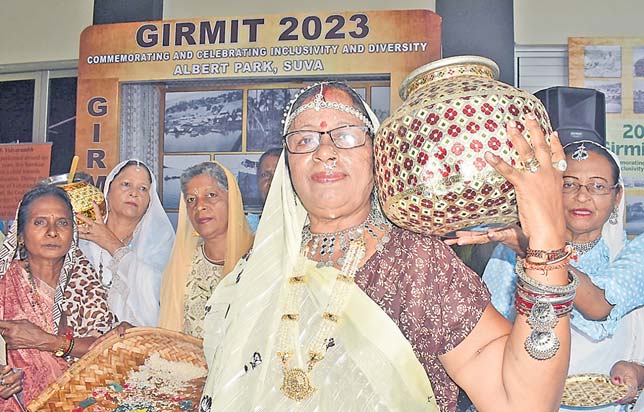In the last article in this series, I focused on the activities and festivities that were organised to mark the arrival of the girmitiya in Fiji.
In the process, I outlined a number of things that stood out in the organisation of these events.
In this piece, let me elaborate and discuss one key point enumerated there.
It needs to be recognised at the outset that girmit — the arrival of the Indian in Fiji — was never given the level of national prominence that was accorded it from May 11-15.
National recognition was always a deep and abiding concern among the descendants of the girmitiya who make up the Indo-Fijian portion of Fiji’s population.
A key obstacle in this quest was the polarisation of the Fiji population into two distinct ethnic based political groupings in the lead-up to and especially after independence in October 1970.
A little-understood, but more problematic obstacle was a lack of accord among the girmitiya/Indo-Fijians themselves – the girmitiya voice was always blighted by political bickering.
This had its genesis in the girmitiya struggles for political recognition in the country that they had been brought to with promises of riches and prosperity.
The drudgery, inhumanity and cruelties of indentured life evolved into new hope when they were systematically led to make critical decisions after five and then 10 years of their existence as indentured labourers in Fiji.
From 1916, when emigration via girmit was finally ended, the girmitiya were represented in the racially compartmentalised Legislative Council by a single nominated member — a wealthy and well-connected Rakiraki farmer Badri Maharaj.
He was imposed by the colonial administration over popular choice, an Indian lawyer Manilal Doctor, who was sent to Fiji by Mahatma Gandhi in 1912 to assist the girmitiya with issues arising in official dealings with the colonial administration.
Right there was seen the colonial hand in driving a schism among the girmitiya as a community.
This unsympathetic and scheming hand would persist and the resultant divide was to plague the girmitiya, the Fiji-Indian and later the Indo-Fijian throughout their political existence in Fiji.
Manilal Doctor was a fierce defender of the rights of the girmitiya who were now contract farmers and free labourers and it was inevitable that the Australian Colonial Sugar Refinery Company (CSR) and planter community would lobby the colonial government to work on deporting him from Fiji.
This happened in 1920, eight years after his arrival in Fiji, as he participated as a leader in what is referred to as “the Suva strikes”.
Almost one year after this, the spillover of these strikes was seen in Ba on February 11, 1921 as distressed labourers put their tools down.
Soon after this, the strike spread throughout western Viti Levu.
The main point of contention was that as free labourers the girmitiya were still locked into the same perfidious, abusive and unfair conditions of employment that prevailed during girmit.
Sadhu Vashisht Muni, who took on the reins from the banished Manilal Doctor, worked at the forefront of these strikes.
The key point here is that the Indians were mainly labourers, small time farmers and cane growers.
They were no match for the CSR and powerful planter lobby that considered them conniving, demanding and distrustful.
Of greater importance to this article is the fact that after the strikes of 1920-1921, the focus of the Indians moved to enfranchisement.
This was granted in 1929 as three reps — Pundit Vishnu Deo, James Ramchandar Rao and Parmanand Singh — became the first elected Indian representatives in the newly established Legislative Council.
Within two weeks of taking their seats, they demanded common roll and upon being refused, walked out.
Two weeks later, two of them returned accepting that their demand was unrealistic given the circumstances.
Suffice to say, the concept and demand for common roll remained with the Indians even though it was vehemently opposed by the planters, the colonial government and sections of the Muslim community who wanted separate representation for themselves.
This created another divide among the Indians.
Still later, as the Indian cane growers population expanded, interested moved to organising them as a union which could help improve the power imbalance that they had been struggling through in the sugar industry where most of them were clustered because of historical developments.
In 1937, the Kisan Sangh was formed with Pundit Ajodhya Prasad, MT Khan, Dildar Shah and a few others at its forefront.
By 1941 (despite repeated efforts by CSR to disable it), “about 75 per cent of the growers, nearly three thousand, were members of the Kisan Sangh, which by 1943 had a limited capital of ten thousand pounds sterling” (Lal, 2011, p.77).
The government then advised the CSR to recognise the Sangh, and it did this with great reluctance.
Initially, the Sangh delivered results for its members, but over time, a number of key persons in the Indian community began to quietly question the hidden agenda, motivations and sometimes irregular activities of the Kisan Sangh leaders.
Prominent among these were AD Patel, Vishnu Deo, Said Hasan and SB Patel among others.
The most affected lot under the apparent neglect of the Kisan Sangh were South Indians who had arrived later in the early 1990s and were
the last to shrug off the shackles of girmit.
The irregular activities of the Kisan Sangh mentioned here are outlined in researches, but what is important for us is that AD Patel, Sadhu
Kuppuswamy, Swami Rudrananda and a number of other key persons formed the Maha Sangh in June 1941 as a reaction to the growing disaffection with the Kisan Sangh.
This divide in the sugar belt would plague sugar politics and the whole of Indo-Fijian politics later.
Readers will have noted that the key leaders of the Maha Sangh appeared at the forefront of the National Federation Party in June 1964.
This did indeed happen as the Maha Sangh became the begetter of the NFP and the Kisan Sangh gravitated towards Ratu Mara’s Alliance Party with Vijay Singh at its helm.
One became the “opposer” and the other the “comprador”.
Significant realignments took place after the coup of 1987 as the Fiji Kisan Sangh aligned itself with the Fiji Labour Party.
At this point the Kisan Sangh expired and its supporters moved to the National Farmers Union (NFU) whose founding general secretary, Mahendra Chaudhry, revitalised the NFU as a political force in the 1990s amid an extremely hostile political environment.
The Kisan Sangh/FLP vs Maha Sangh/NFP rivalry thus moved back to the sugar belt as the Fiji Cane Growers Association was formed with NFP backing to challenge the NFU.
A mutually debilitating rivalry ensued and returned to national politics as Mr Chaudhry and Jai Ram Reddy locked horns in a bitter duel to annihilation.
We covered in detail earlier how Mr Reddy and Mr Sitiveni Rabuka cooperated in bequeathing Fiji the acclaimed 1997 constitution with Mr Chaudhry and remnants of the Taukei Movement mudding the background throughout the painstaking process.
That close cooperation and mutual trust resurfaced between the Peoples’ Alliance Party (PAP) and the NFP in the lead-up to the 2022 general election.
At the helm were the same Mr Rabuka with Professor Biman Prasad for the NFP this time.
The rules of the game had changed with the D’Hondt system being used, but the need for cooperation among political parties, especially across the ethnic divide, was even more acute.
If this was seen as the ticket to a broad-based government in 1999 under the 1997 constitution, it was now a necessity as the Fiji- First government had apparently locked-in all of the key institutions of state.
True to trends (and character), the non-FFP electorate was heavily fractured.
Mr Chaudhry offered the non-FFP Indo-Fijian voters an alternative to Mr Prasad.
It is no secret that he has vowed to drub the NFP into the ashes of history and this was another shot at it.
On the other hand, the non-FFP Fijian electorate had PAP, SODELPA and Unity Fiji — a fragmented i-Taukei front that surfaced and became entrenched after the 1987 coup.
Polling results dictated a coalition if FFP was to be denied another term as the electorate had become alarmed and bitter with its non-consultative, arrogant and overbearing style of government.
What is significant for this column is that Mr Prasad stood unwaveringly beside Mr Rabuka while SO- DELPA publicly courted the FFP in an effort to squeeze the lotto-type opportunity to its fullest.
That was keenly watched by the public and for the ideas being developed through these series, the Fijian was seeing trust, support and cooperation from an Indo-Fijian for a prominent Fijian leader who was once a hero of the ethno-nationalists.
The cycle was complete — the Indo-Fijian had finally behaved in a manner that invoked respect and acceptance among the i-Taukei.
What transpired after that was played out during the unprecedented Girmit Celebrations of May 2023.
I will elaborate on this further in my next article.
• DR SUBHASH APPANNA is a USP academic who has been writing regularly on issues of historical and national significance. The views expressed here are his alone and not necessarily shared by this newspaper or his employers





